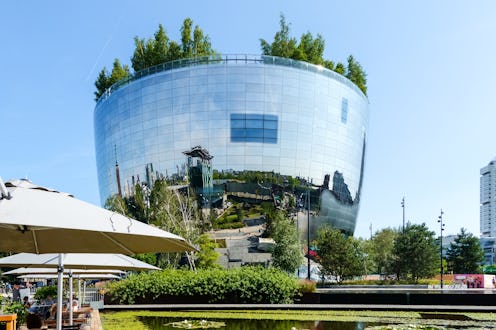(Travel)
The Design Lover’s Guide To Rotterdam
Where to eat, shop, and explore in the Netherlands’ coolest creative hub.

When most travelers think of the Netherlands, they beeline for Amsterdam — and rarely look back. But just 30 minutes away by train, Rotterdam is quietly claiming the spotlight as Europe’s new capital of cool.
Unlike Amsterdam’s postcard-perfect canals, Rotterdam was largely rebuilt after World War II. The result? A striking retro-futuristic skyline, with angular ‘60s buildings and bold new projects that feel tailor-made for the Instagram age. Long Europe’s busiest port, the city has always been a hub where migration, commerce, and culture intersect — making it a perfect case study for the “second-city” travel trend, where in-the-know visitors skip overcrowded capitals for more creative alternatives.
Here, it’s less about checking off tourist landmarks and more about aesthetic discovery. Rotterdam’s design DNA shows up everywhere: in its skyline, its food halls, and even in the way locals live. With the recent opening of the Fenix Museum of Migration and a wave of new avant-garde architecture, the city is officially a cool-hunter’s paradise.
Over the summer, I carved out one stylish day in Rotterdam, determined to pack in as much art, design, and architecture as possible. Here’s the ultimate guide to spending 10-ish hours in the Netherlands’ most under-the-radar city.
Arrival: Centraal Station’s Space-Age Welcome
You’ll likely arrive by train into Centraal Station, a striking, angular hub that feels like the set of a sci-fi film. Its diagonal roof swoops directly toward the city center, pointing you to Rotterdam’s modernist core.
The Market Moment
Markthall isn’t just a place to shop. It’s a landmark. The soaring, horseshoe-shaped building houses more than 90 food stalls beneath arching apartments. Overhead, the “Horn of Plenty” by artist Arno Coenen — the world’s largest artwork — spans more than 13,000 square yards. The mural lights up the hall’s vast interior, depicting fruit tumbling from a summer sky, grazing cows, and flowers. (Think: Sistine Chapel, only trippier.)
Graze your way through Dutch staples: herring from Adalus Fish, Gouda from Cheese & More, and stroopwafels from Goudstroop. Then, duck around the corner for a steaming bowl of ramen and fried chicken dumplings at locals’ fave Hinoki Noodle Soup.
Icon Status: The Cube Houses
Just a short stroll away, Piet Blom’s Cube Houses deliver Rotterdam’s most recognizable photo op. Tilted 45 degrees, these bright yellow apartments balance like dice mid-tumble. The geometric homes are meant to maximize living space while minimizing the footprint on the ground. Stepping into the courtyard feels like a fun house. The apartment complex looks like a beehive and a tree canopy, all at once.
After more than 40 years, all 38 homes are still inhabited. Pop into the Kijk-Kubus Museum-house to see what it’s really like to live inside. You’ll navigate three floors of sharp angles and steep stairs.
Waterfront Suds
Break for a drink at Fenix Food Factory, a buzzing waterfront warehouse reimagined as a street-food hall. Grab a table facing the harbor and order a flight at Kaapse Kaap, the taproom of a beloved local brewery pouring 32 beers that change weekly.
All The Way Up
Next door, the Fenix Museum of Migration opened in May 2025 in a historic 1923 Holland America Line shipping warehouse. It’s on the very dock from which millions, including Albert Einstein and Willem de Kooning, departed for new lives in America.
It’s Rotterdam’s biggest cultural launch in years. The design, centered around a soaring double-helix metallic staircase by Ma Yansong of MAD Architects and dubbed the Tornado, is a dramatic new addition to the skyline. While the media often portrays migration as traumatic, the architect wanted the museum to feel hopeful, light, and even playful. Starting from the lobby, I climb the twisting Tornado as it winds past the museum’s exhibit floors and pierces the roof. When I step outside, the cantilevered structure gave me the feeling of floating over the harbor, as if on the bow of a ship.
Inside, the light-filled galleries display art created by migrants like de Kooning, mixed with haunting artifacts and historical documents.
Cruise Control
Yes, a harbor cruise sounds touristy — but Rotterdam’s version is next-level. Hop on the modern Spido for a 75-minute ride past futuristic skyscrapers, buzzing shipyards, and the towering SS Rotterdam (a retired cruise ship turned boutique hotel and bar). You’ll get glimpses of the city’s maritime history and giant shipping industry, and an up-close view of the city’s famed architecture.
Stop, Sip, Stroll
Cap your day with a wander down Witte de Withstraat, Rotterdam’s so-called “Axis of Art.” The street is lined with contemporary galleries, indie boutiques, and street murals, with buzzy cocktail bars tucked between. Order a nightcap, toast the city’s creative spirit, and catch the train back to Amsterdam.